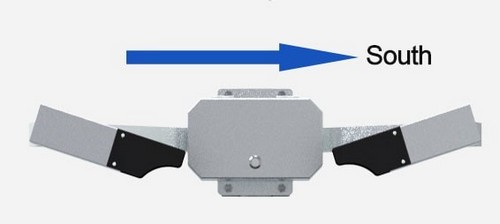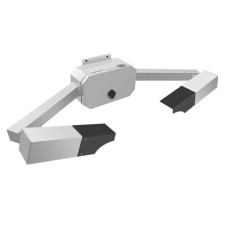For Downloads | ||
| Setup Software | Testing Software |
For Purchase | Call / WhatsApp / Telegram: +91 8148834200 | |
For Technical Support | Call / WhatsApp / Telegram: +91 8148834211 | |
|
Before Buy Choose the Options |
||
|
Distance |
Cost |
|
|
2 kms |
Rs.133970 |
|
|
10 kms |
Rs.141626 |
|
|
50 kms |
Rs.156937 |
|
|
80 kms |
Rs.172247 |
|
The visibility sensor uses
high-sensitivity infrared light, and the interior is filtered to eliminate
interference from other light sources. So as to ensure the accuracy of the
measurement. The housing of the atmospheric visibility sensor is made of sturdy
alloy, and the surface is added with anti-corrosion materials to prevent
corrosion in harsh environments. Atmospheric visibility can be monitored 24
hours a day. We provide RS485 and WIFI two signal outputs to meet the needs of
customers in different places.

Visibility sensor adopts infrared
forward-scatter technology, and it uses the proven 35° scatter angle to report
the meteorological observable range (MOR) for fog and snow in the range of 5 to
10000 m (or 5-50000m/5-80000m). It combines a high specification with a very
competitive price. Visibility sensors are often used in traffic, ports, tunnel,
Wind energy, automatic weather stations and other industries.
Datasheets
|
Power supply |
10~30V |
|
Range |
5-10000m/5-50000m/5-80000m |
|
Accuracy |
±10% (@25℃,50%RH) |
|
Resolution |
1m |
|
Update interval |
20s |
|
MTBF |
> 18000 hours |
|
Working environment |
-40~60℃, ≤95%(30℃) |
|
Weight |
<10kg |
|
Output signal |
RS485/WIFI |
|
Place of origin |
China |
Features
1. The optical lens of this
visibility sensor is facing down and has a protective cover to prevent
precipitation, droplets or dust from entering the lens and reduce probe
contamination. This design measures more accurately and requires no
maintenance. The overvoltage and electromagnetic protection functions of the
visibility sensor ensure safe operation.
2. This sensor can sample
continuously at high speed, improving the accuracy of measurements in mixed
weather such as rain and hail, while providing reliable readings in more stable
weather such as fog and mist. High-speed sampling also allows the sensor to
better respond to suddenly changing conditions.
3. This sensor is very
energy-efficient, with a working power consumption of only 0.5W under normal
circumstances, saving energy. The internal circuit is an anti-interference
treatment. Good stability.
4. The DC power supply circuit of
the visibility sensor has an anti-reverse and self-recovery insurance design to
avoid sensor damage due to operational errors.
5. The surface of the visibility
sensor is treated with anti-corrosion to resist rainwater corrosion. Robust and
seawater-proven visibility sensors designed for applications in all climatic
zones, both onshore and offshore. It provides reliable data even under extreme
environmental conditions.
Working principle - visibility sensor

The transmitter emits infrared
pulsed light, and the receiver simultaneously detects the pulsed light
intensity forward scattered by aerosol particles in the atmosphere. All
measurement information is collected by the microprocessor controller and
converted into meteorological optical range (MOR) through professional
mathematical model algorithms.
When used
outdoors, the visibility sensor is fixed on the metal pole, and the fixed
location can be monitored 24 hours a day.
FAQ -
visibility sensor
1. What is
atmospheric visibility?
Atmospheric
visibility is an indicator of atmospheric transparency. It is generally defined
as the maximum horizontal distance on the ground that a person with normal
vision can clearly see the outline of the target under the prevailing weather
conditions.
2. What is an
atmospheric visibility sensor?
The
visibility sensor is a device used to measure atmospheric visibility. It can
provide measurements related to meteorological transparency. The principle of
the sensor is designed based on the principle of aerosol forward scattering. It
is a new generation of meteorological visibility monitoring equipment developed
after the transmission visibility meter.
3. How to
install the visibility sensor?
Choose a
suitable location to install the visibility sensor, provide mounting hoop, use
the hoop to install the sensor on the 75mm pole, pay attention to the
installation direction.

NOTE:
Install the sensor approximately 2 meters above the ground. Make sure that
there are no other objects under the sensor that interfere with the test. The
ideal installation site should be at least 100 meters away from large buildings
or other facilities that generate heat and prevent rainfall, and avoid the
influence of tree shade. The site should be free of obstacles, reflective
surfaces and obvious sources of pollution that interfere with optical
measurements.
Atmospheric Visibility Sensor
- Product Code: RS-NJD-N01-1
- Availability: Out Of Stock
-
Rs.133,970.00
Available Options
Tags: atmospheric, visibility, sensor

